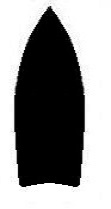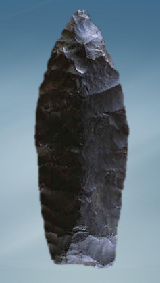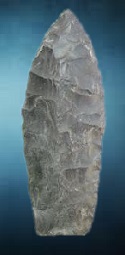

This point is primarily found in the Brooks Range of Alaska and into Artic regions of Canada.
MESA (Lanceolate) – was named by archaeologist Michael Kunz for examples recovered from the Mesa archaeology site in Alaska’s Brooks Range above the Arctic Circle. They are medium to large sized (2 ½” to 4”), thick bodied lanceolate (projectiles and knives) with convex or straight bases (unless the base has been damaged or reworked). The point gradually expands from the base to its widest extent, which usually occurs at about two thirds of its length. Heavy basal edge grinding is usually present to approximately the widest extent of the point. They were roughed out by percussion flaking and finished by horizontally opposed pressure flaking. Flake removal terminates along their centerline, creating a biconvex cross section. Distribution includes Canada, Alaska and they were in use during the Arctic Paleo period.
References: Baker, Ele (Tony), personal communication. Kunz, Michael L. 1982, The Mesa Site: An Early Holocene Hunting Stand in the Iteriak Valley, Northern Alaska. Anthropological papers of the University of Alaska 20 (1-2):113-122. Kunz, Michael L. 2003, The Mesa Site: Paleoindians Above the Arctic Circle. BLM-Alaska Open File Report a Doty


Kunz is an archaeologist for the BLM in Fairbanks Alaska. He has surveys and studies into the archaeology of Alaska. This point was named in a professional publication and has many references. This is considered a valid type.
.